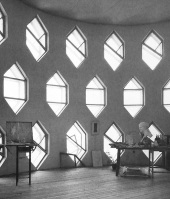 Neuerscheinungen 2015Stand: 2020-02-01 |
Schnellsuche
ISBN/Stichwort/Autor
|
Herderstraße 10
10625 Berlin
Tel.: 030 315 714 16
Fax 030 315 714 14
info@buchspektrum.de |

Fritz Barth
Konstantin Melnikov and his House
2015. 64 S. 240 mm
Verlag/Jahr: EDITION AXEL MENGES 2015
ISBN: 3-936681-90-2 (3936681902)
Neue ISBN: 978-3-936681-90-1 (9783936681901)
Preis und Lieferzeit: Bitte klicken
Konstantin Melnikov (1890-1974) is unquestionably one of the outstanding architects of the 20th century in spite of the fact that he fell silent early, leaving behind only limited work that was insufficiently publicized, and restricted almost exclusively to Moscow, the city of his birth in which he spent nearly his entire life and which did not appreciate him. He was raised in humble circumstances, but enjoyed an excellent education. Beginning in the mid-1920s, after the turmoil that followed the war, revolution and civil war, his career soared at almost meteoric speed as he took the lead in the young Soviet architecture movement with completely autonomous, highly artistic buildings that were free from dogmatism of any kind. Even more rapid than his rise to fame was his downfall: Treated with general hostility, he was unable to defend himself against the accusation of formalism when Stalin put an end to architectural ventures and experiments around the mid-1930s. He was expelled from the architects´ association and was banned from practicing as an architect for the remaining four decades of his life.
In the late 1920s, at the peak of his career, he had the opportunity to build a house for himself and his family in Moscow, in which he was then able to live until the end of his life. This house, a memorable symbiosis of almost peasantlike simplicity and extreme radicalness, is one of the most impressive, surprising and probably most enigmatic works produced by 20th-century architecture. Its simplicity is only outward; in reality this is a highly complex work which links together the elements of architecture explicitly and inextricably, which takes a clear and completely autonomous stand and which, in a way that little else has done, raises the question as to the nature of genuinely architectonic thinking. In essayistic form the book attempts to follow the paths laid out in the architect s work from the perspective of an architect.
Fritz Barth studied architecture in Stuttgart and Zurich. He runs an architect s practice in Fellbach near Stuttgart, teaches at the TU Darmstadt and is the author of a series of books, including a study on the iconography of 16th-century Italian gardens (Die Villa Lante in Bagnaia, 2001), a monograph about the Bohemian Baroque master builder Johann Santini-Aichel (Santini, 2004) and a study of the fortifications of Francesco di Giorgio Martini (Martial Signifiers. Fortress Complexes by Francesco di Giorgio Martini, 2011).
Fritz Barth studied architecture in Stuttgart. He was written a monograph about the Villa Lante, a garden from the 16th century (Die Villa Lante in Bagnaia, Edition Axel Menges, 2001), and another one about Johann Santini Aichel, a Bohemian late-Baroque architect (Santini, 2004). He runs an architecture firm in Fellbach near Stuttgart, and also occasionally works as a photographer.


